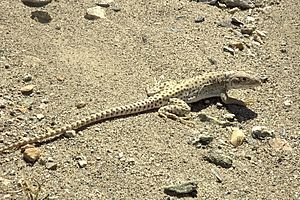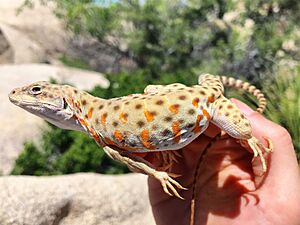Long-nosed leopard lizard facts for kids
Quick facts for kids Long-nosed leopard lizard |
|
|---|---|
 |
|
| Taken at Mojave Desert | |
| Conservation status | |
| Scientific classification | |
| Genus: |
Gambelia (lizard)
|
| Species: |
wislizenii
|
| Synonyms | |
|
|
The long-nosed leopard lizard (Gambelia wislizenii) is a type of large lizard found in North America. These lizards can grow to be about 3 to 5.75 inches (8 to 15 cm) long, not counting their tail. They have a big head, a long nose, and a long, round tail that can be even longer than their body!
This lizard is related to the blunt-nosed leopard lizard (Gambelia sila). They look very similar, but the blunt-nosed leopard lizard has a shorter, blunter nose. Even though their homes are sometimes damaged by human activities, long-nosed leopard lizards are not considered to be in danger.
Contents
What's in a Name?
The scientific name, wislizenii, honors a German-American doctor and naturalist named Friedrich Adolph Wislizenus. He was the first person to find a specimen of this lizard near Santa Fe, New Mexico.
Appearance and Features
Long-nosed leopard lizards have bumpy scales on their backs. These scales can be white, cream, or gray. They have irregular brown or dark gray spots all over their body and head. Sometimes, they even have dark stripes across their back and tail.
Young lizards have brighter markings than adults. They might have rusty colors or bright red spots on their backs. Their thighs and the underside of their tail can be yellow.
Differences Between Males and Females
Male and female long-nosed leopard lizards look a bit different. Females are usually larger, growing to about 5.8 inches (15 cm) long from snout to vent (the opening at the end of their body). Males are smaller, around 4.8 inches (12 cm) long.
Both male and female lizards can change their colors! When they are in their dark phase, their spots almost disappear. Light stripes become very clear on their body and tail. In their light phase, their main color can be gray, pinkish, brown, or yellowish-brown.
During the breeding season, females develop reddish-orange spots and stripes on their sides. They also get these colors underneath their tail when they are pregnant. Males get a pink or rusty color on their throat, chest, and sometimes their body during this time.
Where They Live and Their Home
Long-nosed leopard lizards like dry and semi-dry flat areas. They prefer places with scattered low plants like bunch grass, sagebrush, and creosote bush. The ground can be hard, sandy, or even gravelly with rocks. They often use these rocks to warm up in the sun.
These lizards like open spaces where they can run easily. They avoid areas with lots of thick plants. You can find them from sea level up to about 6,000 feet (1,800 meters) high. Their home range stretches across the western United States, from Oregon to Idaho in the north. It goes south into northern Mexico, including Baja California, Sonora, Coahuila, and Zacatecas. They are also found in places like Casa Grande, Arizona and the desert areas east of the Peninsula Ranges in San Diego County.
Behaviors and Habits
You can often spot long-nosed leopard lizards on small rocks along roadsides. They love to bask in direct sunlight to warm up. They are diurnal, which means they are active during the day. They can be active all day long when the weather is mild or warm.
Their day usually starts early, between 5:30 AM and 8:30 AM, depending on where they live. After warming up in the sun, they start actively hunting for food.
Defense Mechanisms
When a long-nosed leopard lizard senses danger, it uses a special defense called "freeze" behavior. It will run under a bush, flatten its body against the ground, and stay perfectly still until the danger is gone. If they are caught, they can even drop their tail! This is called caudal autotomy. The tail keeps wiggling, distracting the predator while the lizard escapes.
Their speed and quickness are very important for catching prey and escaping from predators. When they run very fast, they lift their front legs off the ground.
What They Eat
Long-nosed leopard lizards are predators. They eat insects, other small lizards, and sometimes even small rodents. They are also known to eat smaller leopard lizards if they get the chance. Sometimes, they will eat young leopard lizards right after they hatch. However, adult lizards are usually not active when most young hatch, which gives the babies time to grow bigger and stronger.
Their long nose helps them have a quicker jaw, which is great for catching other lizards and small animals. They hunt by stalking and ambushing their prey. This means they hide in the shadows under a bush or small tree. Their spotted pattern helps them blend in. They wait for their prey to come close enough. When it's time, they pounce quickly to grab the prey with their strong jaws. These lizards have even been seen jumping up to 2 feet (60 cm) in any direction, even into the air, to catch their food!
Sometimes, a leopard lizard might try to swallow prey that is too big. There have been cases where they choked to death because of the size of the animal they tried to eat.
Predators
Many animals hunt long-nosed leopard lizards. These include different kinds of birds, snakes, coyotes, badgers, and the kit fox.
Reproduction and Life Cycle
The breeding season for long-nosed leopard lizards is from May to June. Females usually lay one clutch of 5 to 6 eggs in June or July. These eggs hatch in late summer, around July or August. The parents do not stay together after mating.
Most females lay one clutch of eggs per year. However, in warmer southern areas, a female might lay up to two clutches. The eggs are laid in a burrow, but the lizard doesn't build a special nest. It takes about five to seven weeks for the eggs to hatch. The young lizards come out in August, which is when the adult lizards are becoming less active. This timing might help prevent the adults from eating the young ones.
Conservation Status
The blunt-nosed leopard lizard (Gambelia sila), which is a close relative, is an endangered species. Its habitat has been greatly changed by farming, city growth, overgrazing by animals, oil wells, mining, and off-road vehicles. This habitat loss continues to be a problem for them.
However, the long-nosed leopard lizard (Gambelia wislizenii) is not currently facing any specific conservation concerns. It is listed as "least concern," meaning its population is stable.



